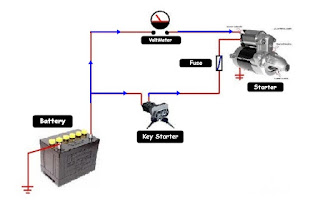3 Type of Starter System And Its Functions. Automotive, Technology, Electrical, Starter System,
Technology Automotive - 3 Type of Starter System And Its Functions -
FUNCTION 3 TYPE OF STARTER SYSTEM
1. As the prime Mover, when the engine was first turned on
3 TYPES OF THE STARTER SYSTEM:
1. Planetary Type.
In this type of starter uses three pieces of gear as armature shaft armature as well as the armature drive itself before turning the clutch and pinion gear.
2. Reduction Type.
In this type of starter there are gear-gear that reduces from the armature coil to the gear on the coupling shaft.
3. Conventional Type.
In this type of starter there is only one gear that is pinion gear that will connect to fly wheel gear when drive lever push the gear when the starter spins.
Explanation
Let's just talk about the main point of the article. To narrow the subject matter about starter system, I will only discuss about conventional type starter system only. like the picture below.
MAIN COMPONENTS AND CONVENTIONAL STARTER TYPE SYSTEM FUNCTIONS
1. SWITCH STARTER
To disconnect and connect the electrical current from the battery
2. SPRING PLUNGER
To restore the plunyer position after pressing and pushing the drive lever
3. PLUNGER
To push and hook the drive lever
4. DRIVE LEVER
To push the clutch and pinion gear to connect to the flywheel gear
5. FRONT CASE
To close the front of the starter
6. STOP COLAR
To limit the movement of the clutch and pinion gear on the shaft
7. PINION GEAR
To play the pinion gear
8. STARTER CLUTCH
To limit the quick rotation of the clutch
9. ARMATURE
To cause a magnetic field in a circular direction
10.COMUTATOR
For the position of the charcoal brush that will drain the electricity to the armature so that it goes round
11.WASHER
To limit and lock the rear axis of the starter
12.FIELD COIL
To cause the magnetic field in a straight and horizontal direction
13.BRUSH HOLDER
For positions of positive and negative brushes
14.BRUSH
To conduct an electric current on the commutator
15.REAR CASE
To close the front starter
16. BOLT
To tie the whole component of the starter system
MAIN COMPONENTS MAIN SYSTEM STARTER CONVENTIONAL TYPES
2. ARMATURE.
Function: To generate a magnetic field in a circular direction.
3. CIRCUITS AND BRUSHES.
Function: as a place of positive and negative brush position and also to conduct electrical current at commutator.
4. SWITCH STARTER.
There are 3 Terminals on the starter switches: 30, 50 and C
and there are also two main coils: Pull in Coil and Hold in Coil.
HOW TO STARTER SYSTEM WORK IN THE CIRCUIT?
Thank you for visiting and reading on our site Technology Automotive. See you later.

















